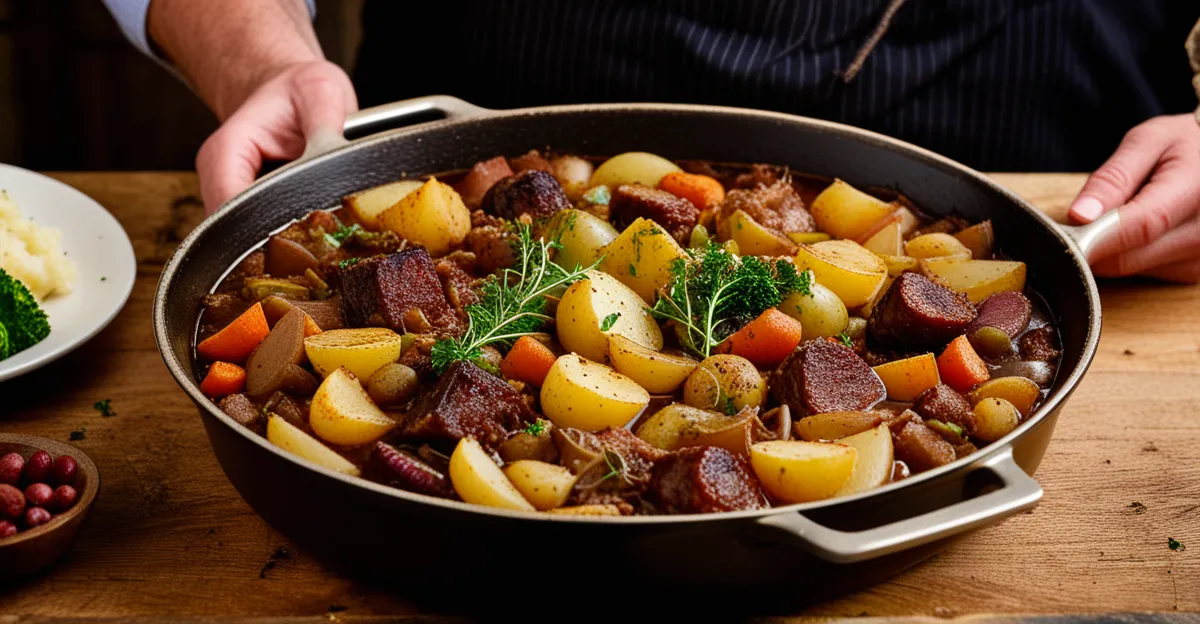Essential Ingredients in a Traditional Lancashire Hotpot
Authentic Lancashire hotpot ingredients focus on simplicity and robust flavors. The centerpiece is quality lamb cuts, typically shoulder or neck, which provide richness and tenderness after slow cooking. These cuts are preferred because of their connective tissue and marbled fat that break down beautifully, infusing the dish with depth.
Vegetables play a key role as well. Sliced potatoes and onions are essential and layered to complement the lamb. Potatoes offer a creamy, soft texture as they cook, absorbing juices and enhancing the overall flavor. Onions add subtle sweetness and moisture, balancing the richness of the meat.
Also to read : How can you bake a moist and flavorful Victoria sponge cake?
Classic seasonings include salt, pepper, and herbs like thyme or bay leaves. These traditional seasonings don’t overpower but rather highlight the natural taste of the core ingredients, preserving the authenticity expected in Lancashire dishes. Sometimes parsley or rosemary can be added for extra aroma, but it’s important to remain faithful to the traditional profile.
Additional flavorings such as a splash of stock or meat juices enhance the hotpot, creating a savory gravy that ties the ingredients together during slow cooking. Mastering these traditional hotpot contents is crucial for crafting an authentic Lancashire hotpot experience.
Also read : How Can UK Chefs Innovate Traditional British Dishes?
Layering and Assembly of Lancashire Hotpot
Mastering the hotpot layering technique is vital when preparing an authentic Lancashire hotpot. Start by placing the succulent lamb cuts at the base of the casserole dish. These lamb pieces form the foundation for the dish’s rich flavor, allowing juices to permeate upward as they cook.
Next, scatter sliced onions evenly over the lamb. Onions release moisture and sweetness that complement the savory meat, marrying the flavors beautifully. Then, layer the potatoes on top. The potato topping should be arranged neatly, often overlapping slightly, to ensure even cooking and create that classic golden crust.
The order of these traditional hotpot contents is crucial. Lamb on the bottom guarantees tenderness; onions provide moisture in the middle, preventing the potatoes from drying out. The potatoes form a starchy barrier to trap steam, helping everything cook uniformly.
Regularly moistening the layers with stock or meat juices during preparation helps maintain consistent texture and flavor. This careful assembly process is essential for proper Lancashire hotpot preparation, leading to the harmonious taste and texture that distinguish authentic Lancashire dishes from quick or modern versions.
Traditional Cooking Methods for Lancashire Hotpot
A slow-baked Lancashire hotpot is crucial for unlocking the full flavor and tenderness of the dish. The hotpot cooking method traditionally involves cooking at a low, steady temperature, typically around 150–160°C (300–320°F), for about two to three hours. This prolonged oven-cooked hotpot process breaks down the collagen in the lamb cuts, resulting in tender, juicy meat that melts in the mouth.
Stock or rich meat gravy plays an indispensable role during cooking. Adding a modest amount of stock enhances moisture and infuses the entire casserole with savory depth. It also helps prevent the potatoes and onions from drying out under the heat. The liquid collects at the base, mingling with the lamb juices and seasoning to create a luscious sauce that complements every mouthful.
Maintaining consistent oven temperature and covering the hotpot for part of the cooking time is often recommended to retain steam and tenderness. This slow, gentle heat distinguishes a genuine Lancashire hotpot from quicker or less traditional versions, emphasizing the patience and care necessary for an authentic Lancashire hotpot experience.
Distinctive Features and Cultural Context
Lancashire hotpot holds a significant place in British culinary tradition, especially within Lancashire’s regional cuisine. Its historical origins date back to working-class communities, where this traditional British hotpot was a hearty, economical meal made with readily available Lancashire hotpot ingredients. This history explains its emphasis on simple, robust components like lamb, potatoes, and onions.
What sets the traditional hotpot apart from modern adaptations is its slow-cooked method and faithful use of classic ingredients. Unlike contemporary versions that might add exotic spices or shortcuts, authentic Lancashire hotpots maintain a focus on pure, unpretentious flavour. It celebrates local produce and textures that reflect Lancashire’s agrarian roots.
Culturally, the hotpot symbolizes comfort and community, often enjoyed as a shared meal. Its enduring presence in Lancashire underscores its importance not just as food but as a cultural emblem. This dish represents a bridge between past and present, showcasing how traditional culinary practices remain cherished today. Understanding these distinctive features provides deeper appreciation for the Lancashire hotpot’s legacy and role within British food culture.




